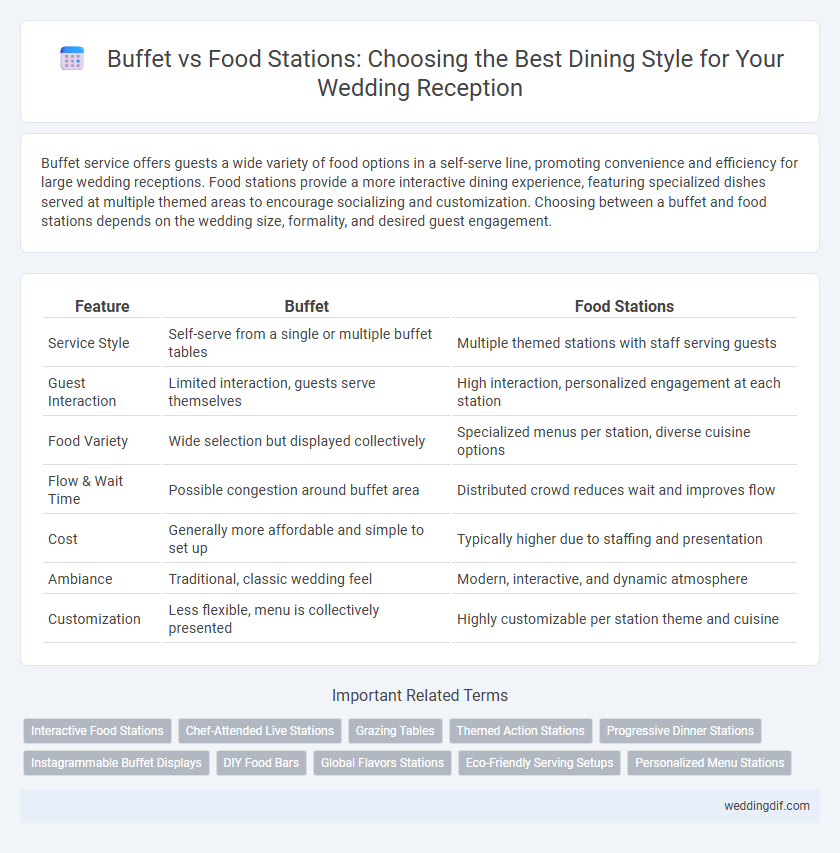Buffet service offers guests a wide variety of food options in a self-serve line, promoting convenience and efficiency for large wedding receptions. Food stations provide a more interactive dining experience, featuring specialized dishes served at multiple themed areas to encourage socializing and customization. Choosing between a buffet and food stations depends on the wedding size, formality, and desired guest engagement.
Table of Comparison
| Feature | Buffet | Food Stations |
|---|---|---|
| Service Style | Self-serve from a single or multiple buffet tables | Multiple themed stations with staff serving guests |
| Guest Interaction | Limited interaction, guests serve themselves | High interaction, personalized engagement at each station |
| Food Variety | Wide selection but displayed collectively | Specialized menus per station, diverse cuisine options |
| Flow & Wait Time | Possible congestion around buffet area | Distributed crowd reduces wait and improves flow |
| Cost | Generally more affordable and simple to set up | Typically higher due to staffing and presentation |
| Ambiance | Traditional, classic wedding feel | Modern, interactive, and dynamic atmosphere |
| Customization | Less flexible, menu is collectively presented | Highly customizable per station theme and cuisine |
Introduction to Buffet and Food Stations
Buffet and food stations offer distinct serving styles for wedding receptions, each enhancing guest experience through variety and convenience. Buffets present all dishes in a single area, allowing guests to serve themselves at their own pace, promoting efficiency and interaction. Food stations, set up as themed or specialty areas, encourage movement and exploration, providing customized options tailored to diverse tastes and dietary needs.
Key Differences Between Buffets and Food Stations
Buffets offer a self-service style with a wide variety of dishes laid out on a single table, allowing guests to choose what and how much they want at their own pace. Food stations feature multiple themed areas, each serving specific types of food prepared or presented in front of guests, encouraging interaction and a more dynamic dining experience. The main differences lie in guest flow, customization options, and the level of staff involvement, with food stations often providing a more personalized and visually engaging presentation.
Guest Experience and Interaction
Buffet setups at wedding receptions offer guests a wide variety of dishes, promoting self-service convenience and faster access to food, which enhances overall satisfaction. Food stations create interactive dining experiences by featuring live cooking or themed cuisine areas, encouraging social engagement and personalized meal choices. Selecting between buffet and food stations depends on the desired guest experience, balancing speed, variety, and interactive elements.
Variety and Customization Options
Buffet-style wedding receptions offer a wide variety of dishes presented simultaneously, allowing guests to choose from multiple options tailored to diverse dietary preferences. Food stations enhance customization by featuring chef-attended setups where guests select ingredients or dishes made fresh to order, creating an interactive dining experience. Both formats elevate variety, but food stations provide greater flexibility for personalized culinary preferences and themed menus.
Presentation and Aesthetics
Buffet setups offer a classic, cohesive presentation with food arranged on long tables, allowing guests to serve themselves efficiently while maintaining a clean and organized visual flow. Food stations create dynamic focal points by showcasing themed or interactive culinary displays, enhancing the overall aesthetic appeal through varied layouts and personalized decor. Choosing between buffet and food stations depends on the desired atmosphere, with buffets emphasizing uniformity and elegance, and food stations providing vibrant, engaging experiences that highlight diversity in presentation.
Space and Venue Considerations
Buffet setups require ample linear space for serving tables and guest flow, making them suitable for larger venues with open floor plans. Food stations offer flexible placement options, ideal for smaller or irregularly shaped spaces by distributing food areas throughout the venue. Venue considerations must include guest traffic patterns and seating arrangements to ensure smooth service and minimize congestion at either buffet or food station layouts.
Staffing and Service Requirements
Buffet setups for wedding receptions typically require fewer staff members, as guests serve themselves, reducing the need for dedicated servers but increasing the importance of monitoring food levels and cleanliness. Food stations demand more specialized staff to prepare and serve dishes on demand, ensuring freshness and customization while managing guest flow efficiently. Proper staffing at food stations enhances the guest experience by providing personalized interactions, though it generally increases overall labor costs compared to buffet service.
Cost Comparison: Buffets vs Food Stations
Buffet-style wedding receptions typically offer a more cost-effective option, averaging $15 to $35 per guest, due to simpler setup and fewer staff requirements. Food stations, while providing variety and interactive dining experiences, often incur higher costs ranging from $25 to $60 per guest because of the need for multiple serving areas and specialized attendants. Couples should weigh the budget impact against the desired guest experience when choosing between buffets and food stations for their wedding reception.
Pros and Cons of Each Style
Buffet service offers guests a variety of food options with the flexibility to choose portions, promoting a casual and social atmosphere but may result in longer lines and potential food waste. Food stations encourage interaction and create a dynamic, themed experience with specialized dishes, though they require more space and can increase catering costs. Selecting between buffet and food stations depends on guest count, venue layout, and desired formality for the wedding reception.
Choosing the Best Option for Your Wedding Reception
Buffet-style service allows guests to choose from a wide variety of dishes at their own pace, promoting a relaxed and social atmosphere ideal for larger wedding receptions. Food stations, on the other hand, offer themed areas with specialized dishes prepared fresh and served by attendants, which enhances guest interaction and provides a more personalized dining experience. When choosing between buffet and food stations for your wedding reception, consider the size of your guest list, venue layout, and the desired level of formality to ensure seamless service and guest satisfaction.
Buffet vs Food Stations for wedding reception. Infographic

 weddingdif.com
weddingdif.com